Aminahassan001
On this page, you find all documents, package deals, and flashcards offered by seller AMINAHASSAN001.
- 456
- 0
- 19
Community
- Followers
- Following
475 items
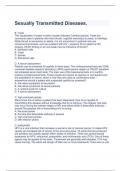
Sexually Transmitted Diseases.
Sexually Transmitted Diseases.B. Yeast The visualization of yeast in saliva usually indicates Candida species. Yeast are commonly seen in patients who have thrush, vaginitis secondary to yeast, or intertrigo. While thrush is uncommon in adults, it is not uncommon in patinets who are immunocompromised, such as a patient with HIV - answerA 35 yo patient is HIV positive. Which finding on an oral swab may be indicative of thrush? A. Epithelial cells B. Yeast C. Spores D. Red blood cells D. A...
- Exam (elaborations)
- • 7 pages •
Sexually Transmitted Diseases.B. Yeast The visualization of yeast in saliva usually indicates Candida species. Yeast are commonly seen in patients who have thrush, vaginitis secondary to yeast, or intertrigo. While thrush is uncommon in adults, it is not uncommon in patinets who are immunocompromised, such as a patient with HIV - answerA 35 yo patient is HIV positive. Which finding on an oral swab may be indicative of thrush? A. Epithelial cells B. Yeast C. Spores D. Red blood cells D. A...
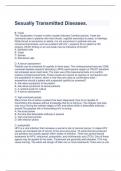
Sexually Transmitted Diseases.
Sexually Transmitted Diseases.B. Yeast The visualization of yeast in saliva usually indicates Candida species. Yeast are commonly seen in patients who have thrush, vaginitis secondary to yeast, or intertrigo. While thrush is uncommon in adults, it is not uncommon in patinets who are immunocompromised, such as a patient with HIV - answerA 35 yo patient is HIV positive. Which finding on an oral swab may be indicative of thrush? A. Epithelial cells B. Yeast C. Spores D. Red blood cells D. A...
- Exam (elaborations)
- • 7 pages •
Sexually Transmitted Diseases.B. Yeast The visualization of yeast in saliva usually indicates Candida species. Yeast are commonly seen in patients who have thrush, vaginitis secondary to yeast, or intertrigo. While thrush is uncommon in adults, it is not uncommon in patinets who are immunocompromised, such as a patient with HIV - answerA 35 yo patient is HIV positive. Which finding on an oral swab may be indicative of thrush? A. Epithelial cells B. Yeast C. Spores D. Red blood cells D. A...
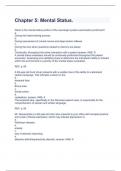
Chapter 5: Mental Status.
Chapter 5: Mental Status. Dementia is the loss of both immediate and recent memory while retaining remote memories. ADHD is associated with recent and remote memory impairment. Impaired judgment is a thought process dysfunction. Stupor is impaired consciousness. REF: p. 70 You ask the patient to follow a series of short commands to assess:
- Exam (elaborations)
- • 11 pages •
Chapter 5: Mental Status. Dementia is the loss of both immediate and recent memory while retaining remote memories. ADHD is associated with recent and remote memory impairment. Impaired judgment is a thought process dysfunction. Stupor is impaired consciousness. REF: p. 70 You ask the patient to follow a series of short commands to assess:
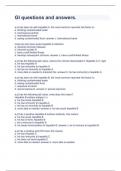
GI questions and answers.
GI questions and answers.a pt has been dx with hepatitis A. the most common reported risk factor is: a. drinking contaminated water b. homosexual activity c. international travel d. eating contaminated food -answer c. international travel most pts who have acute hepatitis A infection: a. develop fulminant disease b. become acutely ill c. have a self-limited illness d. develop subsequent cirrhosis -answer c. have a self-limited illness a pt has the following lab value. what is the c...
- Exam (elaborations)
- • 8 pages •
GI questions and answers.a pt has been dx with hepatitis A. the most common reported risk factor is: a. drinking contaminated water b. homosexual activity c. international travel d. eating contaminated food -answer c. international travel most pts who have acute hepatitis A infection: a. develop fulminant disease b. become acutely ill c. have a self-limited illness d. develop subsequent cirrhosis -answer c. have a self-limited illness a pt has the following lab value. what is the c...
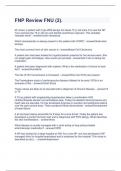
Apea Exam.
Exam (elaborations) FNP Review FNU (2). Exam (elaborations) Endocrine Advanced Practise. Exam (elaborations) Respiratory 2024. Exam (elaborations) Renal NCLEX Questions. Exam (elaborations) NR 661-Mens Health Exam. Exam (elaborations) Health Promotion. Exam (elaborations) NR 661- Professional Issues Comprehesive Exam. Exam (elaborati
- Package deal
- • 8 items •
- Pediatrics Exam 2024. • Exam (elaborations)
- NR 661- Professional Issues Comprehesive Exam. • Exam (elaborations)
- Health Promotion. • Exam (elaborations)
- NR 661-Mens Health Exam. • Exam (elaborations)
- Renal NCLEX Questions. • Exam (elaborations)
- And more ….
Exam (elaborations) FNP Review FNU (2). Exam (elaborations) Endocrine Advanced Practise. Exam (elaborations) Respiratory 2024. Exam (elaborations) Renal NCLEX Questions. Exam (elaborations) NR 661-Mens Health Exam. Exam (elaborations) Health Promotion. Exam (elaborations) NR 661- Professional Issues Comprehesive Exam. Exam (elaborati
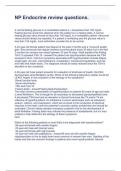
NP Endocrine review questions.
NP Endocrine review questionsA normal fasting glucose in a nondiabetic patient is - answerless than 100 mg/dL. Fasting glucose should be obtained when the patient is in a fasting state. A normal fasting glucose value should be less than 100 mg/dL in a nondiabetic patient. Abnormal values should always be repeated. If a patient is nonfasting and the glucose value is less than 125 mg/dL, most authorities consider this to be normal A 45-year-old female patient has fatigue for the past 3 months a...
- Exam (elaborations)
- • 7 pages •
NP Endocrine review questionsA normal fasting glucose in a nondiabetic patient is - answerless than 100 mg/dL. Fasting glucose should be obtained when the patient is in a fasting state. A normal fasting glucose value should be less than 100 mg/dL in a nondiabetic patient. Abnormal values should always be repeated. If a patient is nonfasting and the glucose value is less than 125 mg/dL, most authorities consider this to be normal A 45-year-old female patient has fatigue for the past 3 months a...

FNP Review FNU (2).
FNP Review FNU (2).Mr Jones, a patient with Type 2DM beings his obese 15 yr old sone in to see the NP. Your examine the 15-yr old son and identify acanthosis nigricans. This probably indicates what? - answerInsulin resistance Which characteristic is always present in the patient with COPD? - answerObstructed airways The most common form of skin cancer is - answerBasal Cell Carcinoma A patient who has been treated for hypothyroidism presents for her annual exam. She c/o weight gain and f...
- Package deal
- Exam (elaborations)
- • 17 pages •
-
Apea Exam. • By AMINAHASSAN001
FNP Review FNU (2).Mr Jones, a patient with Type 2DM beings his obese 15 yr old sone in to see the NP. Your examine the 15-yr old son and identify acanthosis nigricans. This probably indicates what? - answerInsulin resistance Which characteristic is always present in the patient with COPD? - answerObstructed airways The most common form of skin cancer is - answerBasal Cell Carcinoma A patient who has been treated for hypothyroidism presents for her annual exam. She c/o weight gain and f...
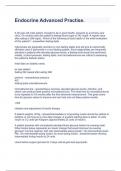
Endocrine Advanced Practise.
Endocrine Advanced Practise.A 38 year-old male patient, thought to be in good health, presents to a primary care clinic. On routine exam the patient's fasting blood sugar is 242 mg/dl. A repeat value after eating is 288 mg/dL. Which of the following is least helpful in the initial evaluation of this patient? - answerNon-fasting lipids riglycerides are especially sensitive to non-fasting states and will give an abnormally elevated value if performed in a non-fasting patient. Since triglycerid...
- Package deal
- Exam (elaborations)
- • 4 pages •
-
Apea Exam. • By AMINAHASSAN001
Endocrine Advanced Practise.A 38 year-old male patient, thought to be in good health, presents to a primary care clinic. On routine exam the patient's fasting blood sugar is 242 mg/dl. A repeat value after eating is 288 mg/dL. Which of the following is least helpful in the initial evaluation of this patient? - answerNon-fasting lipids riglycerides are especially sensitive to non-fasting states and will give an abnormally elevated value if performed in a non-fasting patient. Since triglycerid...
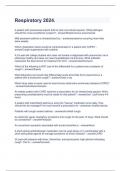
Respiratory 2024.
Respiratory 2024.A patient with pneumonia reports that he has rust colored sputum. What pathogen should the nurse practitioner suspect? - answerStreptococcus pneumoniae Mild persistent asthma is characterized by: - answersymptoms occurring more than twice weekly. Which medication below would be contraindicated in a patient with COPD? - answerCough suppressant with codeine A 24 year-old college student who does not smoke is diagnosed with pneumonia. He is otherwise healthy and does not n...
- Package deal
- Exam (elaborations)
- • 3 pages •
-
Apea Exam. • By AMINAHASSAN001
Respiratory 2024.A patient with pneumonia reports that he has rust colored sputum. What pathogen should the nurse practitioner suspect? - answerStreptococcus pneumoniae Mild persistent asthma is characterized by: - answersymptoms occurring more than twice weekly. Which medication below would be contraindicated in a patient with COPD? - answerCough suppressant with codeine A 24 year-old college student who does not smoke is diagnosed with pneumonia. He is otherwise healthy and does not n...
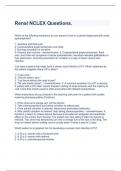
Renal NCLEX Questions.
Renal NCLEX Questions.Which of the following symptoms do you expect to see in a patient diagnosed with acute pyelonephritis? 1. Jaundice and flank pain 2. Costovertebral angle tenderness and chills 3. Burning sensation on urination 4. Polyuria and nocturia - answerAnswer: 2. Costovertebral angle tenderness, flank pain, and chills are symptoms of acute pyelonephritis. Jaundice indicates gallbladder or liver obstruction. A burning sensation on urination is a sign of lower urinary tract infec...
- Package deal
- Exam (elaborations)
- • 12 pages •
-
Apea Exam. • By AMINAHASSAN001
Renal NCLEX Questions.Which of the following symptoms do you expect to see in a patient diagnosed with acute pyelonephritis? 1. Jaundice and flank pain 2. Costovertebral angle tenderness and chills 3. Burning sensation on urination 4. Polyuria and nocturia - answerAnswer: 2. Costovertebral angle tenderness, flank pain, and chills are symptoms of acute pyelonephritis. Jaundice indicates gallbladder or liver obstruction. A burning sensation on urination is a sign of lower urinary tract infec...
